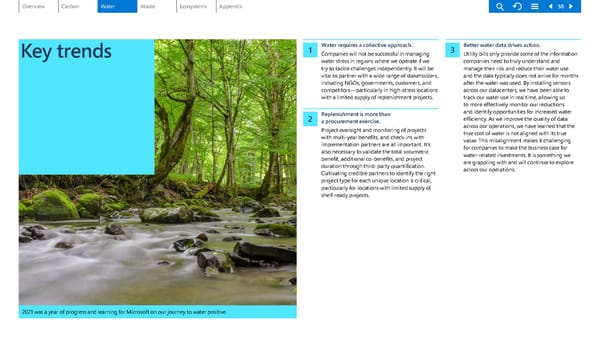Key trends 2021 was a year of progress and learning for Microsoft on our journey to water positive. 1 Water requires a collective approach. Companies will not be successful in managing water stress in regions where we operate if we try to tackle challenges independently. It will be vital to partner with a wide range of stakeholders, including NGOs, governments, customers, and competitors—particularly in high-stress locations with a limited supply of replenishment projects. 2 Replenishment is more than a procurement exercise. Project oversight and monitoring of projects with multi-year benefits, and check-ins with implementation partners are all important. It’s also necessary to validate the total volumetric benefit, additional co-benefits, and project duration through third-party quantification. Cultivating credible partners to identify the right project type for each unique location is critical, particularly for locations with limited supply of shelf-ready projects. 3 Better water data drives action. Utility bills only provide some of the information companies need to truly understand and manage their risk and reduce their water use and the data typically does not arrive for months after the water was used. By installing sensors across our datacenters, we have been able to track our water use in real time, allowing us to more effectively monitor our reductions and identify opportunities for increased water efficiency. As we improve the quality of data across our operations, we have learned that the true cost of water is not aligned with its true value. This misalignment makes it challenging for companies to make the business case for water-related investments. It is something we are grappling with and will continue to explore across our operations. 58
 Environmental Sustainability Report | Microsoft Page 57 Page 59
Environmental Sustainability Report | Microsoft Page 57 Page 59